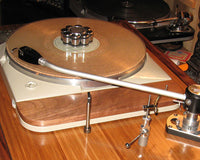Temperature is a major factor to consider when designing with Sorbothane anti-vibration rubber, especially in outdoor and industrial applications. While the material is forgiving and durable, knowing the optimum temperature range of Sorbothane will help you get the most vibration isolation out of your engineering project.
As I detailed in my post The Secret to Easily Custom Cutting Sorbothane Sheets, cold temperatures can temporarily change the properties of Sorbothane in a manner that is helpful to the cutting process. The same can't be said for heat. While extreme cold won't usually cause deterioration of the Sorbothane visco-elastic polymers, high heat will cause degradation.
Optimum Performance Temperature Range for Sorbothane by Durometer:
| Durometer (Shore OO) | Minimum Operating Temperature | Max Operating Temperature |
| 30 | -20 F (-29 C) | 140 F (60 C) |
| 50 | -20 F (-29 C) | 150 F (66 C) |
| 70 | -20 F (-29 C) | 160 F (71 C) |
Sorbothane anti-vibration visco-elastic urethane rubber is the softest urethane rubber available. Its unique internal polymer crosslinking structure allows it to behave like an advanced fluid under proper loading. These internal fluid-like characteristics provide exceptional vibration reduction and energy absorption. However, as the temperature of Sorbothane decreases, it becomes firmer and cannot absorb vibration as effectively. For all Durometers (softness levels) of Sorbothane, the minimum recommended temperature is -20 F (-29 C). Below this the material is still stable but not flexible enough to provide much if any isolation. As the temperature drops the spring rate will increase until Sorbothane reaches its glass transition temperature. When the material temperature returns to the optimum range, the normal anti-vibration characteristics will return.

On the higher end of the temperature spectrum Sorbothane will become exceptionally soft. Exceeding the maximum operating temperature of the material risks permanent deformation and polymer degradation. Keeping Sorbothane within the optimum temperature range ensures that it will remain effective for a millions of cycles or a decade or more.

While all Durometers of Sorbothane have the same minimum design temperature, the maximum operating temperature changes with the durometer. This specification difference is due to the softness change between 30 (very soft) and 70 (firm). 30 Durometer Sorbothane is already very soft and deformable and applying heat reduces its strength and increases its tackiness. Firm 70 Durometer Sorbothane rubber can withstand higher temperatures. This reduction in strength and damping will continue up to 200 F.

Designing with these characteristics in mind will help your vibration isolation application get the maximum benefit from Sorbothane. Adding a thermal insulation layer or choosing an alternate mounting point are both examples of options for ensuring optimum temperatures for Sorbothane. On external applications, be aware that isolation will change with temperature changes. Many types of equipment including motors, laboratory equipment, HVAC units, UAVs, sensors, audio and recording equipment, pumps, robotics, and other industrial machines can all benefit from the effective and efficient vibration isolation offered by Sorbothane rubber.











1 comment
Luis E. Solis
Good morning. I´m using your products in audio / electronics application. Having reviewed the temperature effect affecting the product physical properties. Have following question have an amplifier that weights ca.70 pounds. Under usage it´s temperature can reach 60 65 C (140-150 F). What would be your recommendation on hemisphere usage? I´m considering 2 in diameter 4 hemispheres 70 duro material for this.